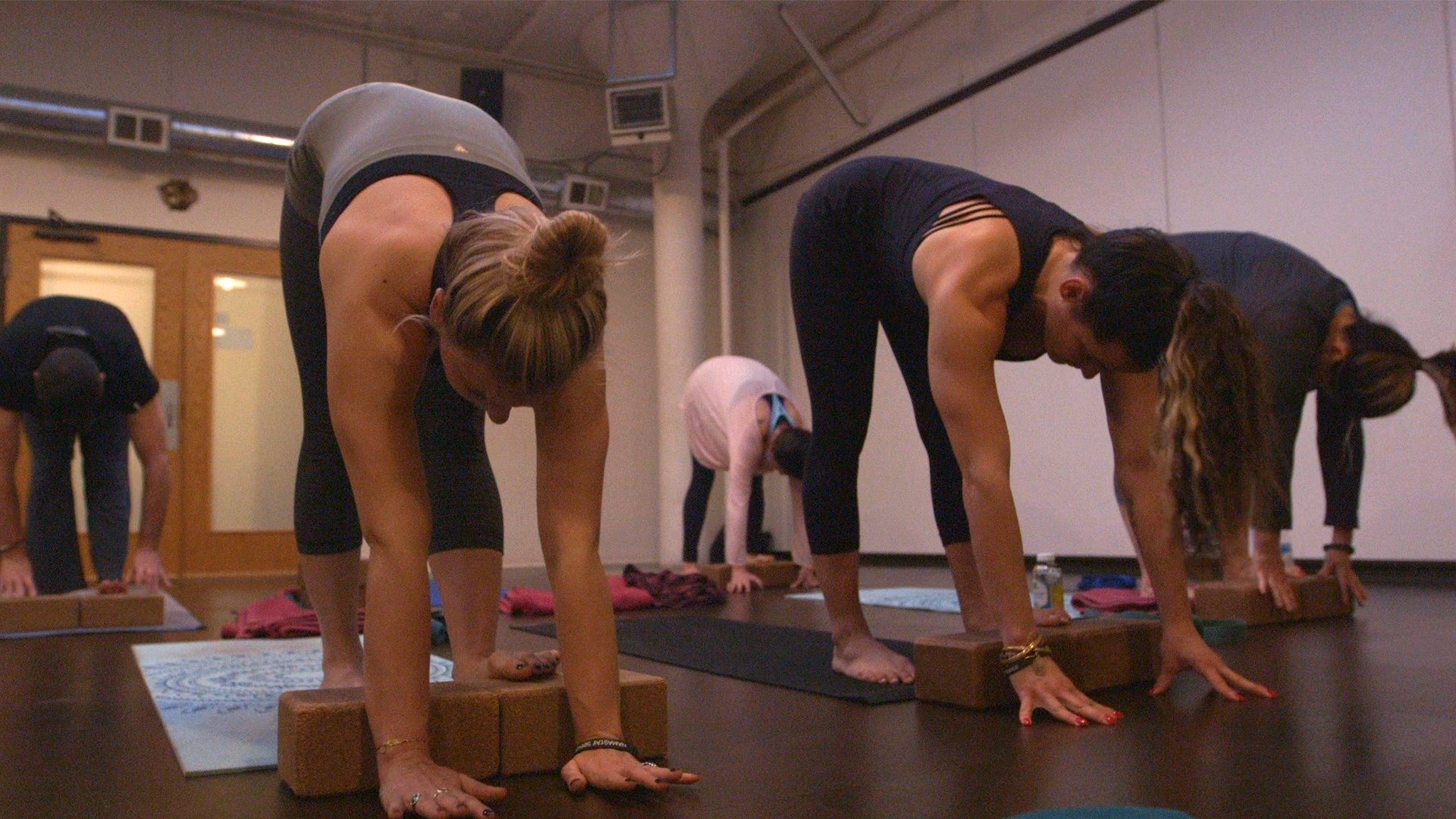I was in mid-sentence, whispering to my friend about how how tranquil the sound of the Tibetan singing bowl is, when a lady across from us turned to me. With a stern look, she raised her index finger to her lips.Shut your mouths—I'm trying to zen out with all these lovely people here in Madison Square Garden, her widened eyes implied.It was 10 am on a Sunday morning in New York, and I was at a group meditation called the Big Quiet, an event organized by and for "modern meditators." This implies younger people seeking their own version of mindfulness that doesn't necessarily include Buddhist austerity or deleting Snapchat. Though to be fair, you have to really be in the moment for Snapchat because those thirst trap pics your "friend" posted won't be around for more than a few views.But I digress. Which is what I usually do in situations where I try to meditate. See, I don't like meditation. Sitting still and breathing deeply while watching your thoughts float by like clouds in the sky? It goes against everything I believe in: Constant movement; shallow, anxious breathing; consciously un-seeing my credit card balance. That's more my thing. It's actually an older-millennial thing in general, I believe—the idea that career is paramount, that we're never getting enough done (hence the anxiety), all followed by crashing on a couch for a weed-fueled Broad City binge."Trying to reach a state of serenity, peace, compassion, and mental clarity, and doing it specifically through regulation of attention—it's not easy," says Lisa Cohen, a psychotherapist and professor of clinical psychiatry at Carl Icahn School of Medicine at Mount Sinai in New York, who uses meditation as a tool with her patients and students. "It's not supposed to be."Oh good. And then a group meditation at that? It brings a whole other element to my epic resistance to it. You want me to connect to my deepest self, all vulnerable and focused…with other people around?It's not just possible, but actually aligned with our basic human needs, according to Jesse Israel, founder of MediClub, the organization that hosts the group events. "We've got people all around us but a lot of us feel very alone. There's a massive disconnect," he says. "[The Big Quiet is] essentially just creating permission for people to come together, to have a gathering. People can come to one of these gatherings, have a moment of quiet, share what's going on in their lives, realize that other people are going through the same thing, and finally have a sense of belonging in a way that we don't often get in our lives."
More from Tonic:
I do see the value in using mindfulness as a vehicle to build a community of like-minded people, especially during a political administration that's effectively shitting all over my and my peers' mental health. And it was nice to let something other than a handle of Tito's (my version of Tina Fey's sheet cake) be my source of calm the week after the Charlottesville riots. Watching hoards of disturbingly organized neo-Nazis on the news made me feel kind of okay about being in a group of peaceful, friendly people who probably don't own guns. Still, sitting on shiny hardwood on a Sunday morning with strangers is kind of off-putting."There's something very powerful about feeling part of a group. And people are nervous about it because it's so powerful. It can make you very self conscious," Cohen tells me. "But the nice thing about meditating is that you don't really have to do anything. You just sit there. You don't have to really talk to anybody. And then once you get into it, then you feel part of this pulsating process that's very enveloping."And so I sat there (not cross-legged), closed my eyes, and focused on my breathing. And then opened them to watch people for a bit. I was there as a journalist, after all. Mostly white people in flowy linen Hamptons attire (the event was $40 to the public) were sitting on cushions and breathing audibly. The sound bath—a mélange of eastern instrumentals that was the soundtrack for much of the 20-minute meditation—ebbed and flowed. I felt weirdly safe in a way I do when I'm completely alone in my apartment, listening to Coltrane, out of reach from any judgement or expectations. To that lady who shushed me, I kind of wanted to be like, Namaste, lady. I get it. This is your Coltrane place.Cohen, after dropping piles of reputable research that shows the clinical benefits of meditation on me, says that most people in her field believe it's an effective way of treating anxiety, depression and day-to-day stress too. "There's a study by Jon Kabat-Zinn where he taught people how to meditate and then looked at their brains," Cohen says. "And there was increased activity in the left prefrontal region, which has been linked to happiness. So most of us in the field of psychology think meditation is a good thing. It helps you calm down. It teaches you how to put yourself in a different mental state."There isn't much clinical research out there on the benefits of group meditation specifically, but as Cohen points out, much of the studies on meditation itself look at practicing together, since many of the experiments place people in groups (some participants are novices and others have been meditating for years). Aside from the advantages each meditator reaps individually, just the act of sitting together is a win, Cohen says. "We're social animals and we conform to group norms automatically. So if you're in a group that's developing group norms such as meditating, turning off your phones, calming down—you're going to orient toward that."In some ways, the "together" part is an illusion, though: Everybody's practice—while in theory is oriented in the same goals—is profoundly different. I spoke to one woman who adds a mantra to her breathing, a man who follows his breath's natural pattern instead of manipulating it, and one woman who eschews silence or sound baths and listens to Alicia Keys instead. That's what calms her. Both Cohen and my yoga teacher tell me that an integral part of practice is observing your thoughts and emotions and letting them pass by without judgment. And that's not something you involve anyone else in.To be honest, I didn't meditate that day at MSG. Meditation is emotional CrossFit. And you can't ask someone who's never done CrossFit to do it with 100 professionals. Instead, I watched other people be alone together, many of their shut eyelids fluttering under the harsh arena lighting. It was delightfully voyeuristic. While I may not be meditator in the traditional sense, being at the Big Quiet reminded me that I can pursue mindfulness anywhere, even if it's not on a cushion, prayer beads in hand. So this past week, while waiting for the pizza guy to heat up my slice, and even once on the L train—as the subway dancer flipped way too close to my head—I stopped to let go of the thought I was clinging to too tightly. I took a deep breath and it passed. And I didn't even need to shush anyone.Read This Next: What I Learned from Teaching High Yoga
Advertisement
Advertisement
More from Tonic:

I do see the value in using mindfulness as a vehicle to build a community of like-minded people, especially during a political administration that's effectively shitting all over my and my peers' mental health. And it was nice to let something other than a handle of Tito's (my version of Tina Fey's sheet cake) be my source of calm the week after the Charlottesville riots. Watching hoards of disturbingly organized neo-Nazis on the news made me feel kind of okay about being in a group of peaceful, friendly people who probably don't own guns. Still, sitting on shiny hardwood on a Sunday morning with strangers is kind of off-putting."There's something very powerful about feeling part of a group. And people are nervous about it because it's so powerful. It can make you very self conscious," Cohen tells me. "But the nice thing about meditating is that you don't really have to do anything. You just sit there. You don't have to really talk to anybody. And then once you get into it, then you feel part of this pulsating process that's very enveloping."And so I sat there (not cross-legged), closed my eyes, and focused on my breathing. And then opened them to watch people for a bit. I was there as a journalist, after all. Mostly white people in flowy linen Hamptons attire (the event was $40 to the public) were sitting on cushions and breathing audibly. The sound bath—a mélange of eastern instrumentals that was the soundtrack for much of the 20-minute meditation—ebbed and flowed. I felt weirdly safe in a way I do when I'm completely alone in my apartment, listening to Coltrane, out of reach from any judgement or expectations. To that lady who shushed me, I kind of wanted to be like, Namaste, lady. I get it. This is your Coltrane place.
Advertisement
